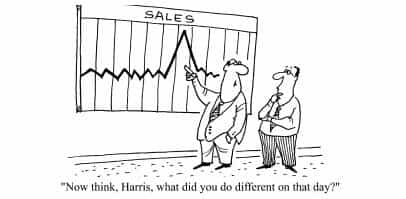Scientific Forecasting – 1 of 4: Why is it important?
Investors pay a premium for growing companies. A close second, and sometimes even more valued benefit is improved revenue predictability. Predictability in forecasting is never bad: not only do investors love it, CFOs love it because expenses and thus cashflows can be managed more precisely, marketing teams love it because they know much pipeline they need to build by when, sales management loves it because they know how many reps to hire by when, and so on. It’s all goodness, right?
Well, here’s a common reality: While often significant amounts of time, energy and precision go into the accuracy of the expense forecast (aka “the budget”), on the revenue side the norm with many startups more often than not is to simply extrapolate growth with usually just a basic spreadsheet or “back of the envelope” calculations. Based on those “estimates”, executive teams often then commit growth plans to their boards (and with them EBIDTA and cashflow projections, profitability metrics, etc.) that ultimately not only drive department budgets, hiring plans, etc., but also their own compensation. All based on “rough estimates”. What could possibly go wrong, you say, right? Read the box below for one story of what did go wrong.
|
At one mid-sized startup, we saw the head of sales depart at the end of Q3, blamed for missing that year’s growth goals. He had delivered higher growth than the company had ever seen, but it was below what the CEO had deemed feasible in the prior December’s “forecast” for the new year. His replacement delivered even less, and that compounding miss eventually caught up with the CEO and the company went through several executive leadership changes. What went wrong? It wasn’t the original sales head’s below-goal growth performance. Instead, it was imprecise forecasting and the resulting, unrealistic goals that unleashed a spiral of political mayhem that lasted years and the company’s valuation stagnated. |
But before diving deeper into what’s at stake with good or bad forecasting, first a bit of theory: When you calculate a number (let’s call it P for Profit) by subtracting a highly precise number with a low uncertainty band (call it E for Expenses; say +/- 1%) from a highly imprecise number with a high uncertainty band (call it R for Revenue; say +/- 10%), the uncertainty band of the calculated number P is greater than the worst of the two uncertainties, i.e. the +/- 10%.
Here is an illustrative example: Say a start-up is expected to lose $2M a year on expected revenues of $25M, or -8%. Now, if the revenue uncertainty is +/-10%, then the year could end at $22.5M or at $27.5M. I.e. the expected profits might range from a loss of $4M to breaking even, depending on the how expenses scale with revenues. So, in this example, 10% revenue uncertainty could translate into a profitability range of -18% to breaking even. Now, how many investors would be willing to pay a premium for the resulting profit or cashflow prediction that has an almost +/- 100% uncertainty around it?
But instead of improving the precision of revenue forecasts, it’s too common to instead rely on adjusting expense budgets, typically quarterly and sometimes more often, to counteract the fluctuations in the actual revenues compared to their original, imprecise forecasts. The resulting rituals of quarterly expense adjustments, re-budgeting, vendor trimming, or even layoffs, etc. aim to ensure the expense lines track the undulating non-attainment of the revenue forecasts. The trouble is that while revenue can almost immediately go down, this common approach to managing the bottom line can cause problems because many expenses cannot be ramped down that fast – even if they would need to be adjusted after a revenue decline, it may not be possible due to existing expense commitments.
In companies not knowing how to precisely manage their forecasts, we’ve seen these expense budget re-adjustments literally consume 10% to 20% of affected departments’ time (often it’s the marketing department as they tend to have the highest non-personnel budgets). That’s wasted time with zero productivity gain (e.g. reduced pipeline from marketing), not to mention the resulting frustrations and morale hits. And to add insult to injury, all too often the hapless “expense victims” get blamed for having “runaway spending”, when the real culprits are companies’ inability to precisely forecast revenue.
Alright, I get why forecasting precisely is important, so what do I do about it?
Many organizations think they know how to forecast growth, but at the end of the day, their forecasts often really neither aren’t all that precise nor accurate. For one, many folks we talk to confuse “sales forecasts” with “forecasting sales”.
The former is what the head of sales puts together to manage, typically this quarter’s sales expectations. Which is different from the latter, which ideally is a rolling 2 to 6 quarter revenue and bookings forecast for the company that’s the basis of its financial projections and budget allocations, especially for marketing departments who have to have a longer planning horizon as some expense commitments get made a year out or more. As we’ve discussed, the latter, especially when done precisely, has a lot of upsides (investors pay a premium, more stable budgets) and avoids downsides (accurate and meaningful analytics, more stable organization, higher morale).
From years in the trenches and having made a living by pegging my own compensation to the accuracy of my forecasts, in the next three blogs we’ll publish tips and how-to’s on how to improve forecasting precision (and thus accuracy) by applying some basic common sense and scientific principles to forecasting.
Don’t turn that dial, we’ll be back with more …








